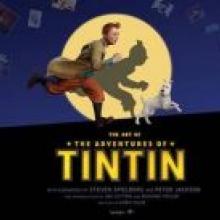
It's always intriguing, and particularly so for another artist, to get an insight into the design process artists go through and both these books convey this thoroughly. Each demonstrates the process of forming a world that a story can convincingly inhabit.

The Art of The Adventures of Tintin, on the other hand, is mostly about the process of recreating a world Herge had already done beautifully, but with much more consideration than he originally required for his 2-D frame-by-frame books, to produce the fully animated 3-D movie, The Adventures of Tintin, out now.
Both books show how Herge and Tolkien often drew on their own real-world experiences for inspiration, as well as gathering research. For example, Herge based Marlinspike Hall on Chateau de Cheverny in the Loire Valley of France and the vessel Karaboudjan (featured in The Crab with the Golden Claws) on an actual ship, the Glenshield. Tolkien's Middle-earth was influenced by his own travels in the Swiss Alps.
As you'd expect, the early pages of The Art of The Adventures of Tintin outline some of the technical challenges and methods employed to produce an entirely CGI realistically rendered, yet still somewhat caricatured film. Having more of an emphasis on the art itself, it's not as heavy on detail, such as describing specific techniques, as an artist might like. The bulk of the book consists of a multitude of scene and set design concepts - some are masterpieces in their own right - captioned by the relevant production team members.
The book further serves to confirm that there is a lot of real talent among Peter Jackson's crew. Nigh on 200 full-colour pages of it.
The Adventures of Tintin has taken five years to produce and, sadly, from an artist's perspective, a lot of the obviously time-consuming effort presented here never even makes it into the movie, merely becoming steps in the visual development progression, which gives quite some appreciation of the dedication and costs involved.
Those familiar with Tintin's adventures will know well the exotic locales and detail Herge portrays them with. It's interesting to read the team still had some difficulty in fleshing this out into a 360-degree world - some scenes only give one or two panels with any significant field of view from which to build a set. Trying to remain loyal to Herge's creation became very challenging, even with seemingly minor issues. One case had the designers struggling to settle on a particular colour of drapes in Tintin's apartment when they are represented differently between Herge's books.
The Art of The Hobbit is quite revealing to those, who like me, are not overly familiar with the visual side of Tolkien's creative talents. He was an amateur artist who had actually formed much of the look and feel of Middle-earth some years earlier while working on his Silmarillion stories.
The book presents the complete range of artwork available, with each chapter dedicated to one of The Hobbit's illustrations. Design development is well covered, from pencil roughs and experimentations - complete with Tolkien's original notes in some cases - through to the more defined inked renderings used in the early publications. Some of the compositions culminate with the lavish watercolours he produced for the latter American publications' colour plates. Included in the 144-page book are a number of double fold-out spreads and, rather than having a dust cover, The Art of The Hobbit is nicely presented in a hard-case sleeve.
- Hayden Smith is a cartoonist and graphic artist for the Otago Daily Times.











